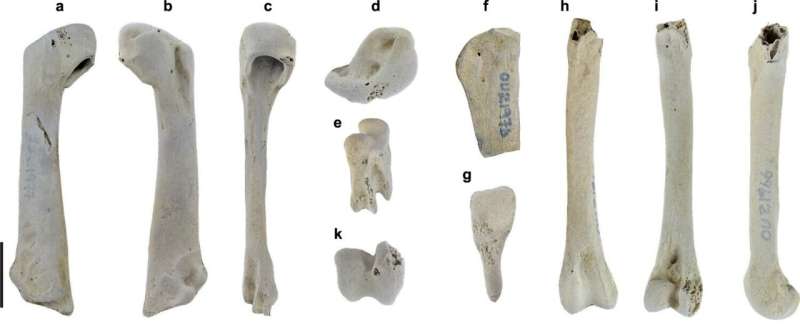
Three small fossil penguin bones, collected in South Canterbury in 1987, are now shedding new light on how penguin wings have evolved. A new study, published in the Journal of the Royal Society of New Zealand, describes a new species of penguin that lived in Otago about 24 million years ago.
Named Pakudyptes hakataramea, the penguin was very small—about the same size as the little blue penguin, the smallest in the world—with anatomical adaptations that allowed it to dive.
Lead author Dr. Tatsuro Ando, formerly a Ph.D. candidate at the University of Otago—Ōtākou Whakaihu Waka and now at the Ashoro Museum of Palentology in Japan, collaborated with researchers from Otago, Okayama University of Science and Osaka University.
Dr. Ando’s inspiration for the paper came from discussions with the late Professor Ewan Fordyce, his supervisor and mentor at Otago.
Researchers analyzed three bones—a humerus, femur and ulna—found by Professor Fordyce in the Hakataramea Valley, South Canterbury.
Dr. Ando says Pakudyptes fills a morphological gap between modern and fossil penguins. “In particular, the shape of the wing bones differed greatly, and the process by which penguin wings came to have their present form and function remained unclear,” he says.
The humerus and ulna highlight how penguins’ wings have evolved.” Surprisingly, while the shoulder joints of the wing of Pakudyptes were very close to the condition of the present-day penguin, the elbow joints were very similar to those of older types of penguin fossils.

“Pakudyptes is the first penguin fossil ever found with this combination, and it is the ‘key’ fossil to unlocking the evolution of penguin wings.”
Co-author Dr. Carolina Loch, from Otago’s Faculty of Dentistry, says analysis of the internal bone structure conducted at the Faculty of Dentistry, with comparison with data on living penguins provided by the Okayama University of Science, shows these penguins had microanatomical features suggestive of diving.
Modern penguins have excellent swimming abilities, largely due to their dense, thick bones that contribute to buoyancy during diving.
In Pakudyptes, the bone cortex was reasonably thick, although the medullary cavity, which contains bone marrow, was open—similar to what we see in the modern little blue penguin, which tends to swim in shallow waters.
The ability for Pakudyptes to dive and swim comes down to the distinctive combination of its bones.
Bones such as the humerus and ulna show areas for attachment of muscles and ligaments which reveal how the wings were being used to swim and maneuver under water.
Dr. Loch says fossil penguins were usually large, about 1m in height. “Penguins evolved rapidly from the Late Oligocene to Early Miocene and Pakudyptes is an important fossil from this period. Its small size and unique combination of bones may have contributed to the ecological diversity of modern penguins.”
More information:
Tatsuro Ando et al, A new tiny fossil penguin from the Late Oligocene of New Zealand and the morphofunctional transition of the penguin wing, Journal of the Royal Society of New Zealand (2024). DOI: 10.1080/03036758.2024.2362283
Provided by
University of Otago
Citation:
Penguin wing fossil shows importance of Zealandia in penguin evolution (2024, August 1)
retrieved 1 August 2024
from https://phys.org/news/2024-08-penguin-wing-fossil-importance-zealandia.html
This document is subject to copyright. Apart from any fair dealing for the purpose of private study or research, no
part may be reproduced without the written permission. The content is provided for information purposes only.
